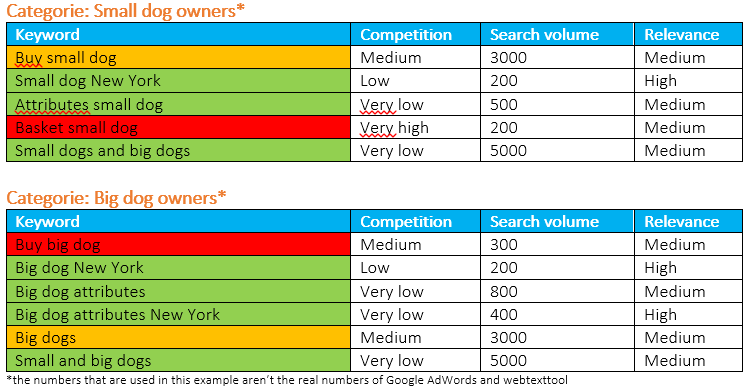Shortlist of subjects
By using the customer journey, like you can read in the previous blog, you’re looking for a list of subjects you can write about. You divide these subjects into different phases or categories. This way you get a clear view of all the possible subjects to write about and you’ll see the overlay of the focus groups.
Part 6: Case Gerards online petshop

There are many more options than the subjects above. Gerard just chose the first things that came to mind while thinking about these steps in the customer journey.
These subjects aren’t automatically the subjects you’ll write about on your business blog. The shortlist serves as the basics for the elaboration of your keyword research, but there is no one right way to map the subjects. If you don’t have any inspiration, just Google and look for other blogs that look alike. Try combining combinations of relevant blog subjects and see what comes up. This could be a great way to expand your shortlist.
The basics of keyword research
You now have collected a shortlist of subject, the next step is to check these keywords. This is where the actual keyword research starts. It’s important to check your subjects to find keywords that will help you to increase your search engine ranking. Also, by reviewing your focus groups search behaviour, you’ll be able to see what information they’re looking for and how to respond to this search for information.
First, you test the subjects on your shortlist by checking the search volume and competition rates. Search volume is the number of searches in a month for a specific keyword. Search volume gives an answer to the question; ‘How many times people search for this subject?’. Competition rates show how many other blogs and websites have written about this subject. If a lot of other blogs and websites write about your subject, the competition rates will be high. Competition rates give an answer to the question; ‘How many other people have written about this subject?’.
Beside search volume and competition rates it’s also important to look at the relevance of your keywords. It isn’t very useful to write about a subject that could get you some traffic, but it doesn’t lure your target audience. Relevance gives an answer to the question; ‘How relevant is the keyword while targeting my focus groups?’.
How to check your keywords?
Checking your keywords can be done many different ways. There are many tools on the internet where you can check for search volume and competition rates. The most famous one is the Google AdWords Keywordplanner. This tool was developed to use for Search Engine Advertising but could also help you to give some insights in the search behaviour of your focus groups while conducting keyword research.
The relevance of a keyword gives the final ‘go’ or ‘no go’ and decides if you’ll write about this subject or not. Imagine, the competition for a certain keyword is very low but the search volume is also low. If this keyword is very relevant to your business blog, it still might be interesting to write about it.
Part 7: Case Gerards online petshop

Determine relevance for content train
The relevance of your keyword can be determined by your own frame of reference. How relevant is the keyword for you focus groups while you want them to find your product? The relevance can be reviewed in three levels: low, medium and high. For your convenience it’s easiest not to make more distinctions. Use relevance in combination with competition and search volume to colour your keywords. Red for useless keywords, orange for possibly interesting keywords and green for the best keywords to use! If you’ve made a good list of interesting keywords, you can continue to make a content train. Read more in the next part of the business blog series: Business blog series part 4: Content train for highest conversion.